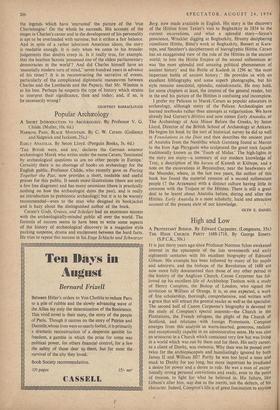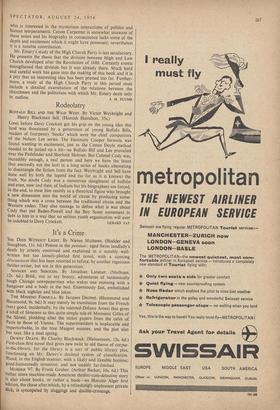High and Low
IT is just thirty years ago since Piofessor Norman Sykes awakened interest in the episcopate of the late seventeenth and early eighteenth centuries with his excellent biography of Edmund Gibson. His example has been followed by many of his pupils and admirers, and the bishops of the Revolution of 1688 are now more fully documented than those of any other period in the history of the Anglican Church. Canon Carpenter has fol- lowed up his excellent life of Archbishop Tenison with a study of Henry Compton, the Bishop of London, who signed the invitation to William of Orange. It is, as one expected, a work of fine scholarship, thorough, comprehensive, and written with a grace that will attract the general reader as well as the specialist. The second half of Canon Carpenter's biography is devoted to the study of Compton's special interests—the Church in the Plantations, the French refugees, the plight of the Church of Scotland, and relations with foreign Protestants. Compton emerges from this analysis as warm-hearted, generous, realistic and exceptionally capable in an administrative sense. He was also an aristocrat in a Church which contained very few but was living in a world which was run by them and for them. His early career, as a client of Danby, was meteoric. Why then was he passed over twice for the archiepiscopate and humiliatingly ignored by both James II and William III? Partly he was too loyal a man and stuck to Danby for too long, but more important he irradiated a desire for power and a desire to rule. He was a man of excep- tionally strong personal convictions and ready, even to the point of treason, to fight for what he believed in. His failure, like Gibson's after him, was due to the merits, not the defects, of his character. Indeed, Compton's life is of great fascination to anyone who is interested in the mysterious interactions of politics and human temperaments. Canon Carpenter is somewhat unaware of these issues and his biography in consequence lacks some of the depth and excitement which it might have possessed; nevertheless it is a notable contribution.
Mr. Emery's study of the High Church Party is less satisfactory. He presents the thesis that the division between High and Low Church developed after the Revolution of 1688. Certainly events strengthened that division but it was already there. Much hard and careful work has gone into the making of this book and it is a pity that an interesting idea has been pressed too far. Further- more, a study of the High Church Party in this period must include a detailed examination of the relations between the churchmen and the politicians with which Mr. Emery deals only



























 Previous page
Previous page